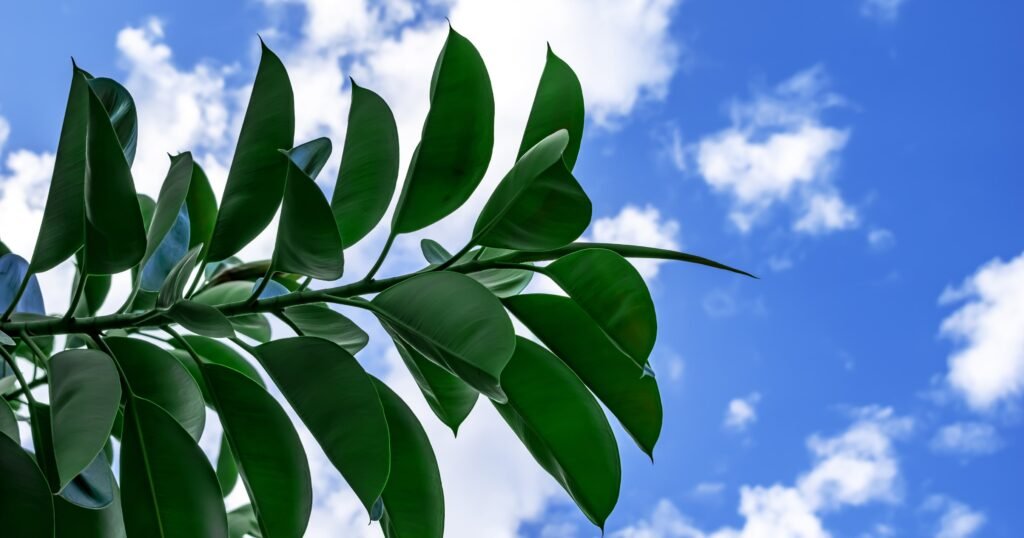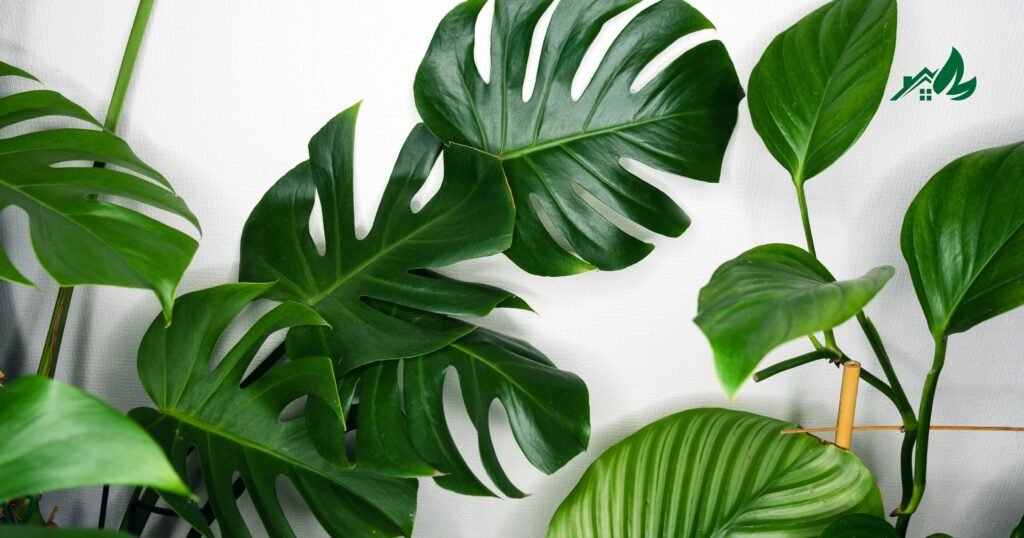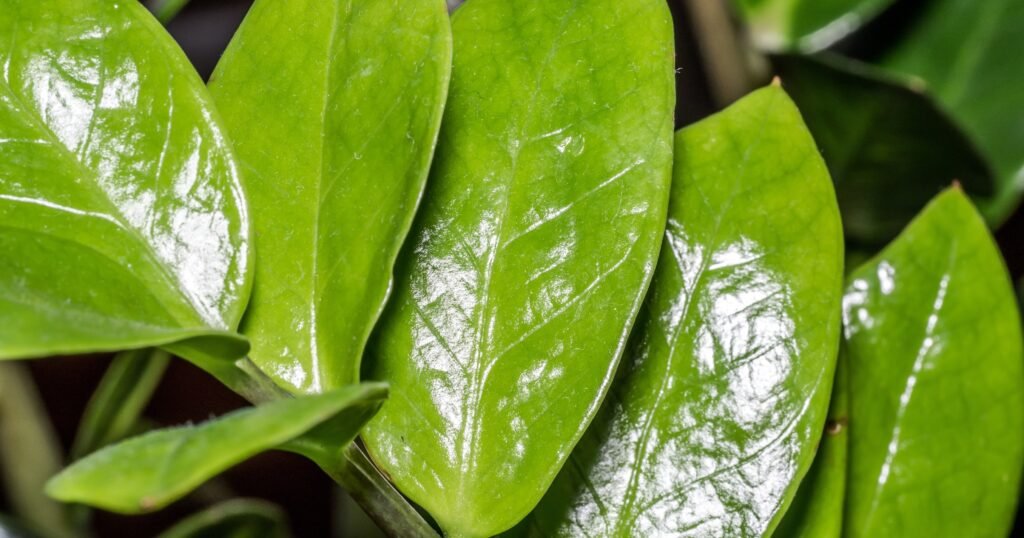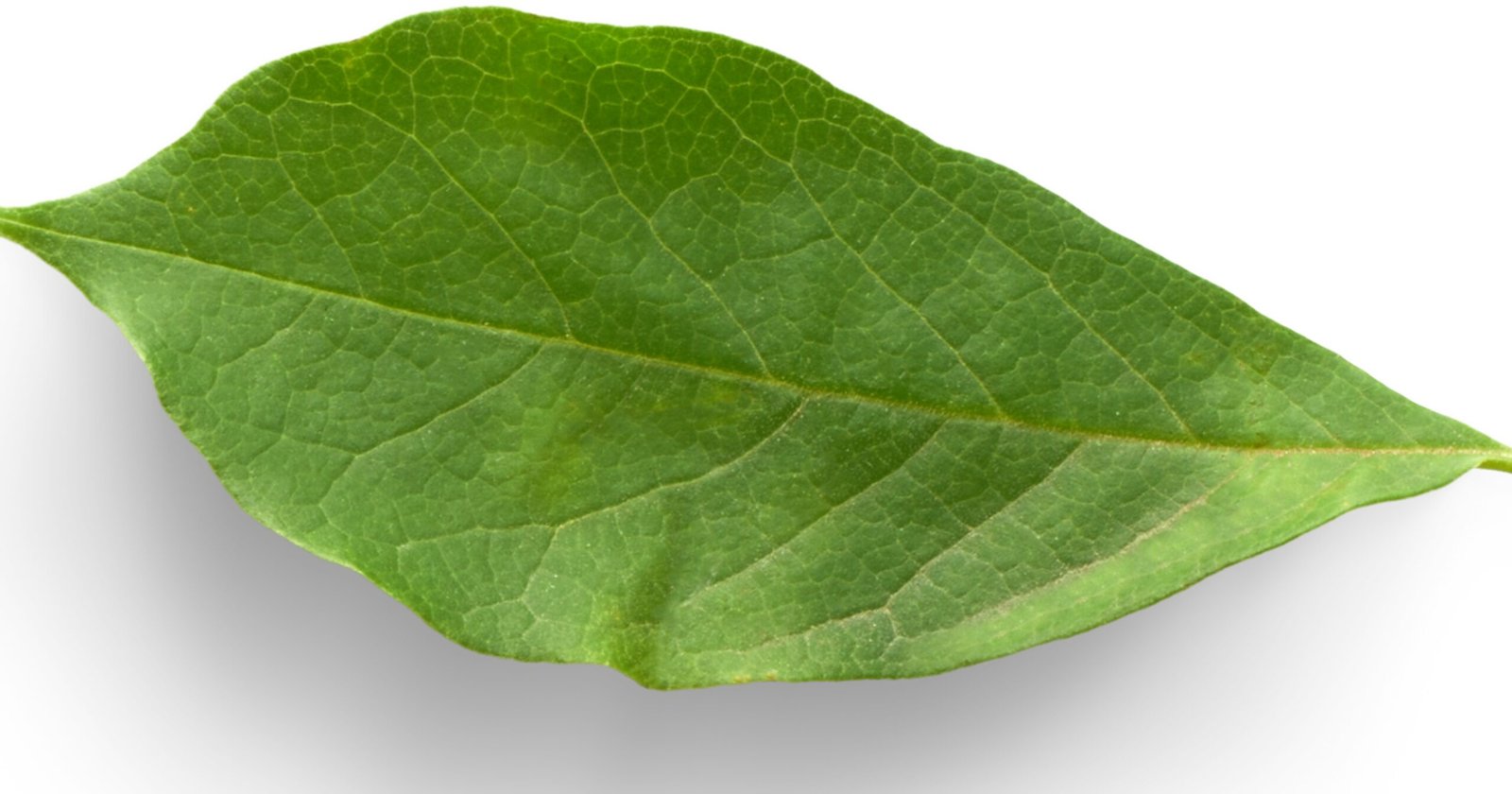Plants with Waxy Leaves List:
- Rubber Plant (Ficus elastica): This popular houseplant has large, glossy green leaves with a thick waxy coating that helps it retain water. Its robust nature makes it an excellent choice for beginners.
- Jade Plant (Crassula ovata): Known for its succulent, waxy leaves, it symbolizes good luck. It prefers bright light and well-drained soil.
- ZZ Plant (Zamioculcas Zamiifolia): The ZZ Plant is notable for its glossy, waxy green leaves. It’s a hardy plant that can survive in low light and drought conditions.
- Begonia: The waxy leaves of Begonias have a beautiful shine and come in various shapes and colors. They prefer indirect sunlight and consistent moisture.
- Hoya Plant: Also known as the wax plant, Hoya has waxy leaves and produces star-shaped flowers. It’s a climbing plant that enjoys bright, indirect light.
Introduction
Plants with waxy leaves have a special allure due to their glossy, shiny appearance and unique adaptations.
A waxy layer on their leaves called the cuticle adds to their aesthetic appeal and serves critical functions for the plants’ survival.
In this article, we will explore a diverse list of plants with waxy leaves, understanding the significance of this characteristic and its advantages to these plants.

The Significance of Waxy Leaves
The waxy coating on the leaves, known scientifically as the cuticle, is instrumental in the plant’s survival and vitality.
The foremost function is to minimize water loss, a crucial adaptation for plants in arid, sun-drenched environments.
The wax forms a hydrophobic layer that restricts the evaporation of water, helping the plant conserve moisture and stay hydrated.
Furthermore, the glossy surface protects against harmful ultraviolet radiation, pathogens, and insect predation.
Thus, the presence of waxy leaves is not just an aesthetic trait but also a strategic adaptation demonstrating nature’s ingenious designs for survival.
1. Water Conservation:
The primary function of the waxy layer on leaves is to minimize water loss through transpiration. This is especially vital in arid or semi-arid regions where water is scarce.
2. Protection from Environmental Stress:
The waxy cuticle protects against harsh environmental conditions such as strong winds, extreme temperatures, and excessive sunlight. It prevents damage to the leaf cells and tissues.
3. Prevention of Pathogen and Pest Attacks:
The waxy layer is a physical barrier, making it difficult for pathogens and pests to breach the leaf surface. This helps in preventing infections and infestations.
4. Optimized Photosynthesis:
The glossy surface of waxy leaves can help optimize the light that reaches the chloroplasts within the leaf cells, aiding in photosynthesis, a process vital for the plant’s growth.

A Diverse List of Plants with Waxy Leaves
1. Hoya Carnosa (Wax Plant):
- Description: Hoya Carnosa, commonly known as the Wax Plant, is a popular houseplant admired for its thick, waxy, and glossy leaves.
- Special Features:
- The leaves are typically oval or elliptical with a waxy texture that gives them a shiny appearance.
- Hoya Carnosa produces beautiful clusters of star-shaped flowers with a waxy texture and a sweet fragrance.
- Benefits:
- The waxy leaves help conserve water, making the Wax Plant adaptable to indoor conditions with minimal watering needs.
2. Echeveria:
- Description: Echeveria is a diverse genus of succulents known for their rosette-shaped, fleshy leaves covered in a waxy cuticle.
- Special Features:
- The leaves come in various colors and forms, ranging from pale greens to purples and reds.
- The thick, waxy cuticle allows these succulents to retain water, making them highly resilient in arid environments.
- Benefits:
- Echeveria plants are low-maintenance and well-suited for indoor and outdoor gardening, especially in arid climates.
3. Agave:
- Description: Agave is a genus of succulent plants known for their thick, fleshy leaves and rosette-like growth habit.
- Special Features:
- The leaves of Agave plants are typically succulent and store water, enabling them to survive in arid regions.
- The leaves’ waxy cuticle protects them from intense sunlight and helps reduce water loss.
- Benefits:
- Agave plants are admired not only for their ornamental value but also for their economic importance in producing agave nectar and tequila.
4. Crassula ovata (Jade Plant):
- Description: Crassula ovata, commonly known as the Jade Plant, is a popular succulent with thick, waxy leaves.
- Special Features:
- The leaves are fleshy and glossy and often have a jade green color, giving the plant its name.
- The waxy cuticle on the leaves allows for water retention and gives the plant a vibrant appearance.
- Benefits:
- Jade Plants are considered symbols of good luck and prosperity and are often kept as indoor houseplants.
5. Camellia:
- Description: Camellia is a genus of flowering plants known for their elegant and glossy evergreen leaves.
- Special Features:
- The leaves are dark green and glossy and have an elliptical shape with serrated edges.
- Camellia plants produce beautiful, showy flowers, further enhancing their ornamental appeal.
- Benefits:
- Camellias are prized ornamental plants widely used in landscaping and gardens for aesthetic beauty.

6. Fatsia Japonica (Japanese Aralia):
- Description: Fatsia Japonica, commonly referred to as Japanese Aralia, is notable for its distinctive leaves that are large, glossy, and deeply lobed. The plant is native to Japan and South Korea, making it an attractive addition to gardens in temperate climates.
- Special Features:
- The leaves of the Japanese Aralia are a standout feature, with their waxy finish giving them a rainforest-like appearance.
- The plant also produces clusters of small, creamy white flowers in autumn, followed by black berries.
- Benefits:
- Due to its bold, exotic-looking leaves, Fatsia Japonica is a favorite choice among gardeners looking to add a tropical touch to their outdoor or indoor spaces.
- The plant’s waxy leaves help retain moisture, allowing it to thrive in sunny and shady conditions with little maintenance.
Conclusion
Plants with Waxy Leaves List? Plants with waxy leaves showcase the marvels of nature’s adaptability and resilience. Their glossy appearance is not just for aesthetic purposes but a vital adaptation for survival. These plants have evolved to optimize water usage, protect themselves from harsh environmental conditions, and reduce the risk of diseases. Incorporating plants with waxy leaves into your garden or indoor space can add to the beauty and provide an opportunity to appreciate the intricacies of nature’s design.
FAQs
15 Plants with Waxy Leaves?
The diversity of plants with waxy leaves is truly impressive, offering an array of species that vary in size, color, and environmental preferences. Plants with waxy leaves list Whether you’re seeking a low-maintenance houseplant or a stunning outdoor specimen, there’s likely a plant with waxy leaves that can fulfill your requirements, adding beauty and interest to your space while showcasing the fascinating adaptability of nature.
What plant has waxy leaves and pink flowers?
The Wax Begonia is a popular plant species with waxy leaves and vibrant pink flowers. This plant thrives in partial shade and requires minimal care, making it a favored choice for indoor and outdoor gardens. Its glossy, verdant leaves and vivid flowers add charm and color, making Wax Begonias perfect for brightening any space.
What is a waxy leaf plant with white flowers?
The Gardenia plant, recognized for its glossy plants with waxy leaves, dark green leaves, and exquisite white flowers, is admired for its breathtaking beauty and strong plants with waxy leaves and sweet fragrance. These plants are an excellent choice for containers or garden beds, where their striking leaves and radiant flowers can create a captivating focal point. Gardenias prefer a sunny to partially shaded location and well-drained acidic soil.
What plant has waxy-looking flowers?
The Anthurium plant, often called the Flamingo Flower, is known for its waxy, heart-shaped flowers. These glossy blooms can be red, pink, lavender, or white and are popular for their long-lasting vibrancy. The Anthurium prefers bright, indirect light and well-drained soil, making it a wonderful option for indoor gardening.

